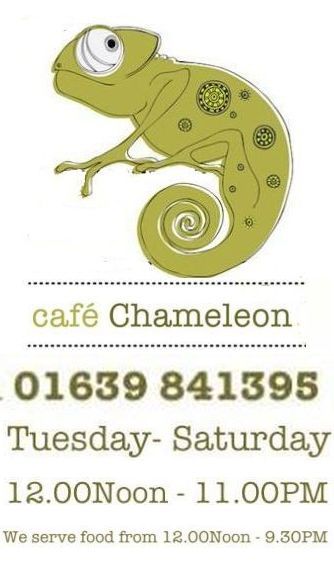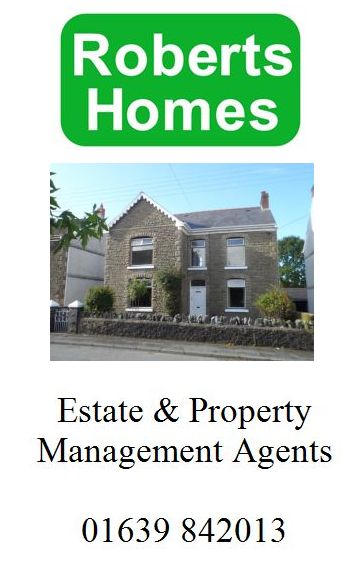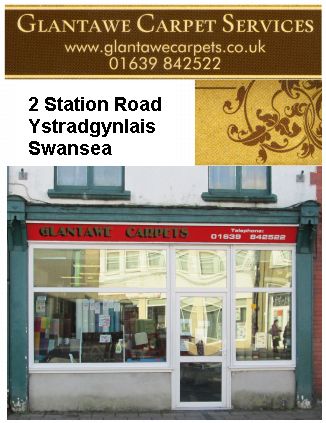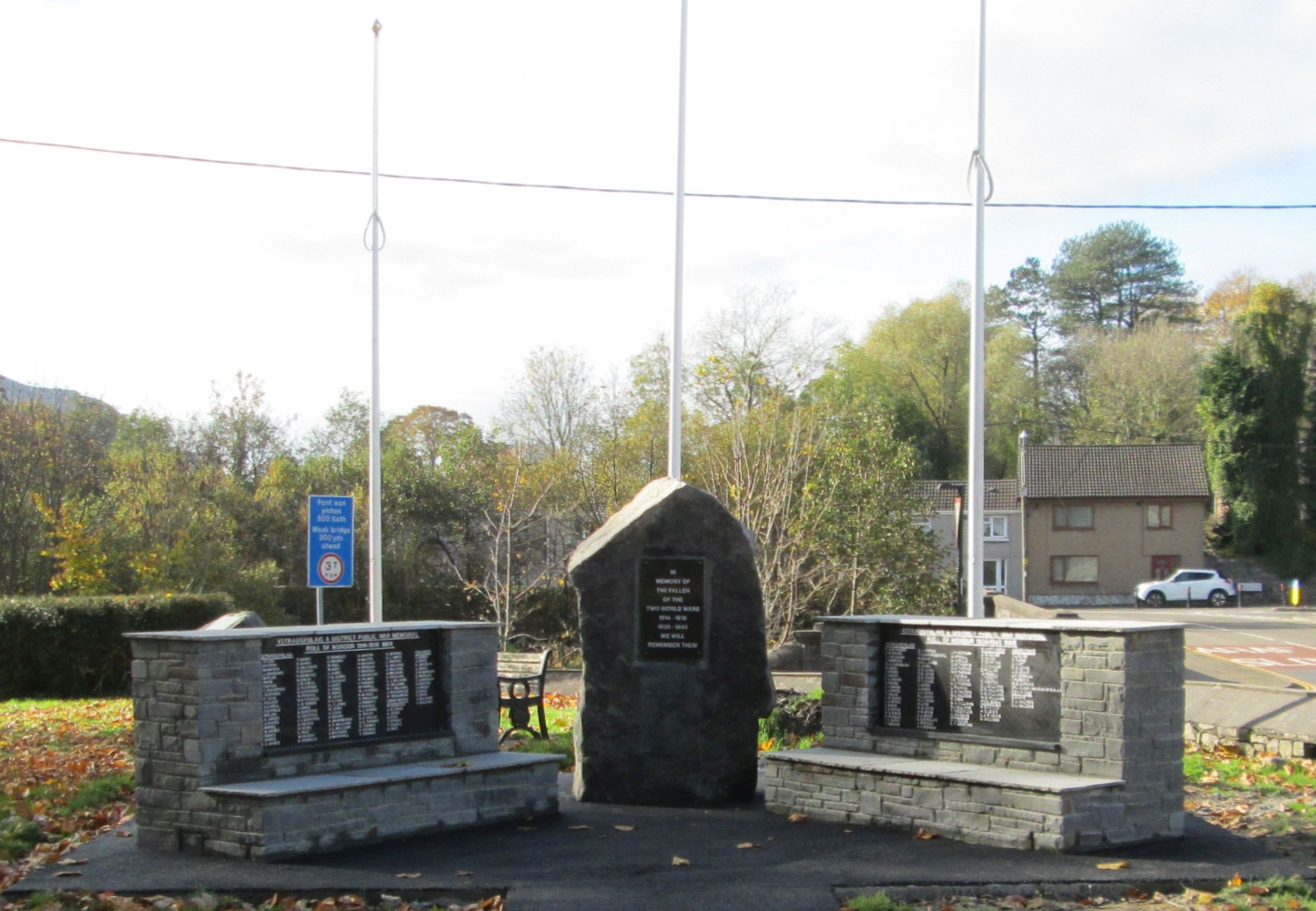Ystradgynlais & District
History and Heritage
Glynmeurig, Ystradgynlais
From the Winter 1948 edition of 'Y Gurnosydd' came a selection of local history articles. One was on Glynmeurig. This article was continued and completed in the subsequent quarterly, the Spring 1949 edition of 'Y Gurnosydd'.
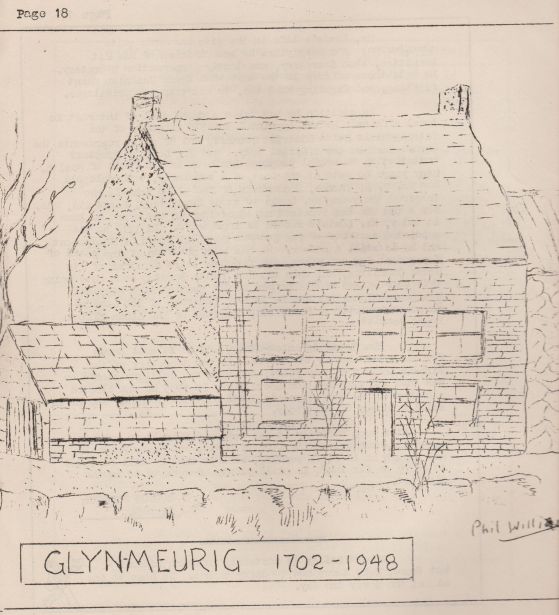
GLYN MEURIG
Page 19
The old farmhouse and land of Glyn Meurig is situated in the parish of Ystradgynlais Lower, in the village of Gurnos, Lower Cwmtwrch which roughly comprises the land which forms the fork between the Tawe and the Twrch (meaning wild boar) which have their confluence near Ystalyfera Grammar School.
It is highly probable that the name Glyn Meurig means the valley of Meurig, though there has been some controversy as to the exact meaning of the word Glyn.
Some antiquarians are of the opinion that this Glyn should be Clyn, which according to them means a hook or crook. The argument is substantiated by the fact that Glynrhebog should be Clyn yr Hebog or Clynhebog. But history seems to indicate that the former meaning is more correct.
It is certain that a Welsh King Meurig of Morgannwg lived somewhere in the locality and that he probably dedicated his name to this particular part of Breconshire: hence the name Glyn Meurig.
This King Meurig of Morgannwg died in 1060.
One thing is certain that the Glyn Meurig family is one of the oldest in South Breconshire and were in bygone days "Yeoman of the Shire of Brecknock".
Even today traversing the upper reaches of the farm, in the Palleg area, are the remains of a Roman road: known to the oldest inhabitants of the district as "Heol y Lladron".
The haunt of thieves and robbers of former days, it seems that this Roman road is on the direct route from Carmarthen (called by the Romans Meridinum) to Colbren (where there are the remains of a Roman road called Sarn Helen) to Neath (called by the Romans Nidum).
During the Roman occupation of Britain this Road must have felt the tread of the Roman Legions, perhaps taking the Britons as slaves, stealing their cattle or going to Dolaucothi in Carmarthenshire to get the gold which was regularly mined there.
Some of the jewellery and ornaments made from Dolaucothi gold mined by the Romans are probably the finest in the whole of Britain.
Fine specimens of those exist today.
And with that Page 23 ends the magazine
THE HISTORY OF GLYNMEURIG
(This is a continuation from the first magazine)
In our last article we were at Lower Cwmtwrch; it is time that we should return to the vicinity of the farm. Near Gurnos Cross, where Mr John Morgan B Sc., now lives, was an old saw pit and sawmills. From the timber sawn at these mills farming implements and boats were made. The boats were taken to the wharf which was opposite the Aubrey Arms and were of course used to carry the commodities along the canal.
So much with the general history of the farm, we must now turn to the history of the family. The old Glyn Meurig family belonged to the Church of England but an ancestor, a woman by the name of Jane Philip George, who came from Llanddeusant and who married into the family, embraced the faith of the Calvinistic Methodists. She was the founder of the Calvinistic Methodism in the Parish of Ystradgynlais. The bold story of the conversion of the family to Methodism was recorded in the Bible of Peter Williams and can be read today at the farm. What we cannot read of course was the family quarrel that accompanied this religious conversion.
In 1823 the Calvinistic Methodists published their "Confession of Faith" and after this we find the family walking from the Gurnos to Cwmgiedd Chapel. It was during one of the services that the grandfather of the present family met his wife -Margaret Rees of Bryndulais Farm, Seven Sisters and when they married two staunch Calvinistic Methodists were united in Holy Matrimony. Their house at Glyn Meurig soon became a meeting place for the Calvinistic Methodists and there are even to this day silver forks which once belonged to the famous Welsh hymn writer, William Williams Pantycelyn at the house.
In the meantime the Phillipiaid had come over from Llanddeusant and had married into the Glyn Meurig branch. Three of the five children of Philip Williams and his wife Margaret, namely Rhys, Susan and Gwenllian were born at the old farm house; whilst Margaret and John were born in the present house.
Education was valued by the family and we find Philip Williams, grandfather of the present occupier sending his sons Rhys and John to be educated at the Normal College Swansea. John later studied medicine at the University of Glasgow but he died when a young man.
In politics the family were Liberals and in 1870 Philip Williams of Glyn Meurig was a member of the Board of Guardians of the Neath Union. The presiding chairman at the time was Howel Gwyn Esq., Duffryn.
Rhys Williams, the son of Philip Williams and the father of the present member of the family, also took a great interest in the welfare of Ystradgynlais. He was a member of the Ystradgynlais Rural District Council and the Pontardawe Board of Guardians were many years. He was also a well-known local antiquarian and a good public speaker. One of his hobbies was verse writing and in 1886 he wrote "A Humble Tribute to Mme Patti on the Occasion of her marriage to Signor Nicolini". This was written to the music of the "Men of Harlech" and with this we bring the history of Glyn Meurig to a close but we have great pleasure in publishing a statement regarding the present situation by Mrs Margareta Hopkins, daughter of Mr Rhys Williams:-
Dear Mr Editor,
Thank you very much for inviting me to write a few lines for the Gurnosydd.
During the last 50 years great changes have taken place at the old Homestead. The March of Civilisation has taken its toll of the land. 50 years ago there were cattle on the fields; rabbits and pheasants in the hedges surrounding the house and gypsies could be seen encamping near the Drill Hall: gypsies who delighted in eating hedgehogs, possessed beautiful caravans, and spoke the romantic Romany language. Now most of the land has been taken for building purposes - houses, a school, a Drill Hall, a Welfare Ground, and a Golf Course.
Those of us who remain of the old family simply think what the past meant to our forefathers and when we see the dear old Glyn Meurig, as it were, wiped out of existence, we can only say with the Bard 'Ti wyddost beth ddywed fy nghalon'.
Margaretta Hopkins
Harold Davies 3A
There was then attached a Note in the 1949 magazine, which we have reproduced as a scanned image below :-
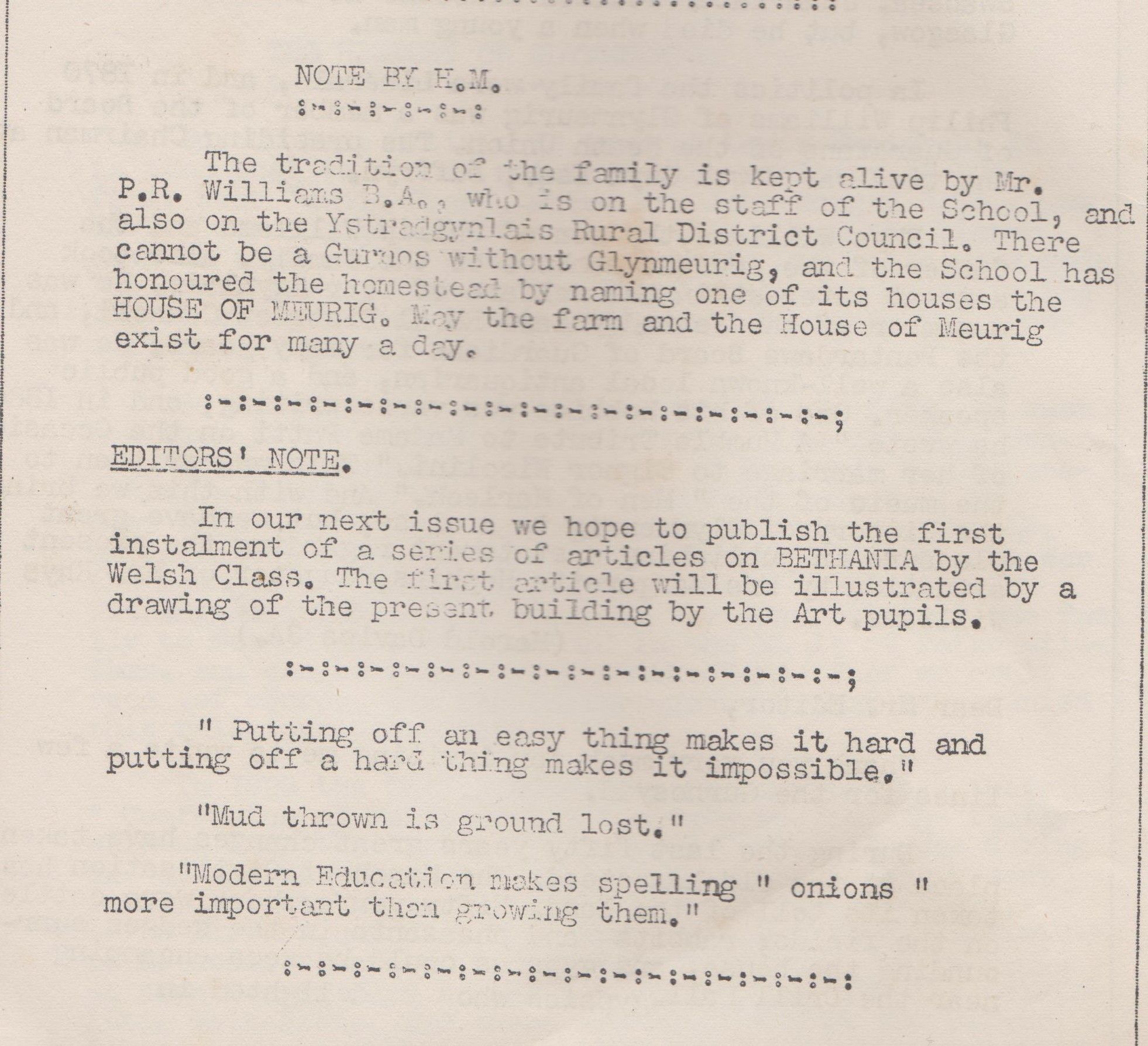
It reads:-
NOTE BY H.M. (HeadMaster)
:~:~:~:~:~:~:~:~
The tradition of the family is kept alive by Mr. P.R. Willims B.A., who is on the staff of the School, and also on the Ystradgynlais Rural District Council. There cannot be a Gurnos without Glynmeurig, and the School has honoured the homestead by naming one of its houses the HOUSE OF MEURIG. May the form and the House of Meurig exist for many a day.
Ystradgynlais - South Wales
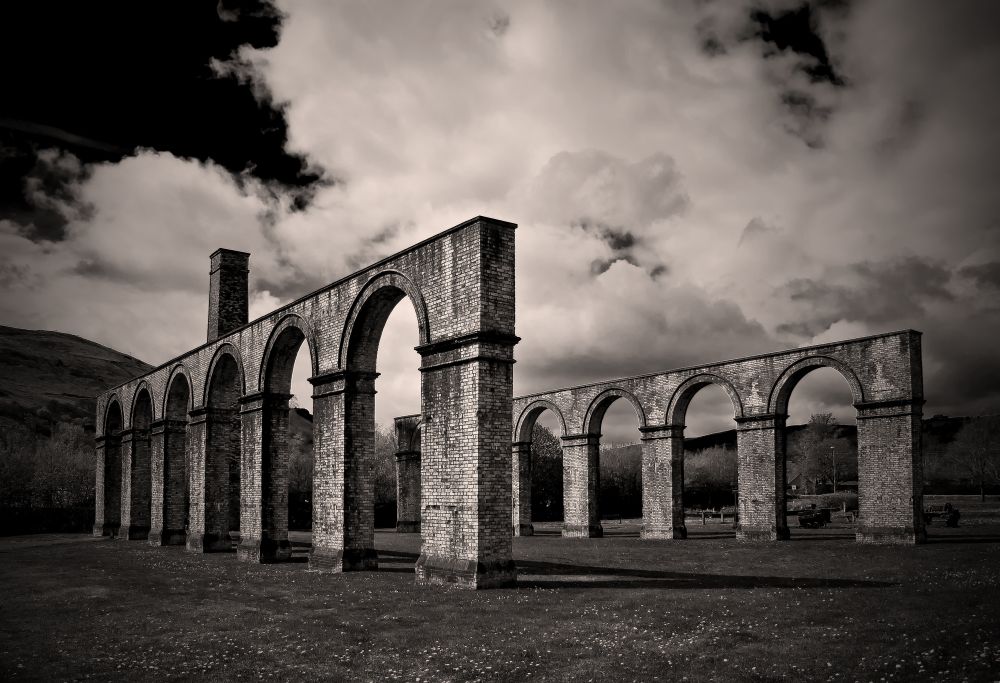
Ystradgynlais History Articles
Email Yeargroup:
yeargroup@hotmail.co.uk
Email Wolfian Design:
webdesign@wolfianpress.com
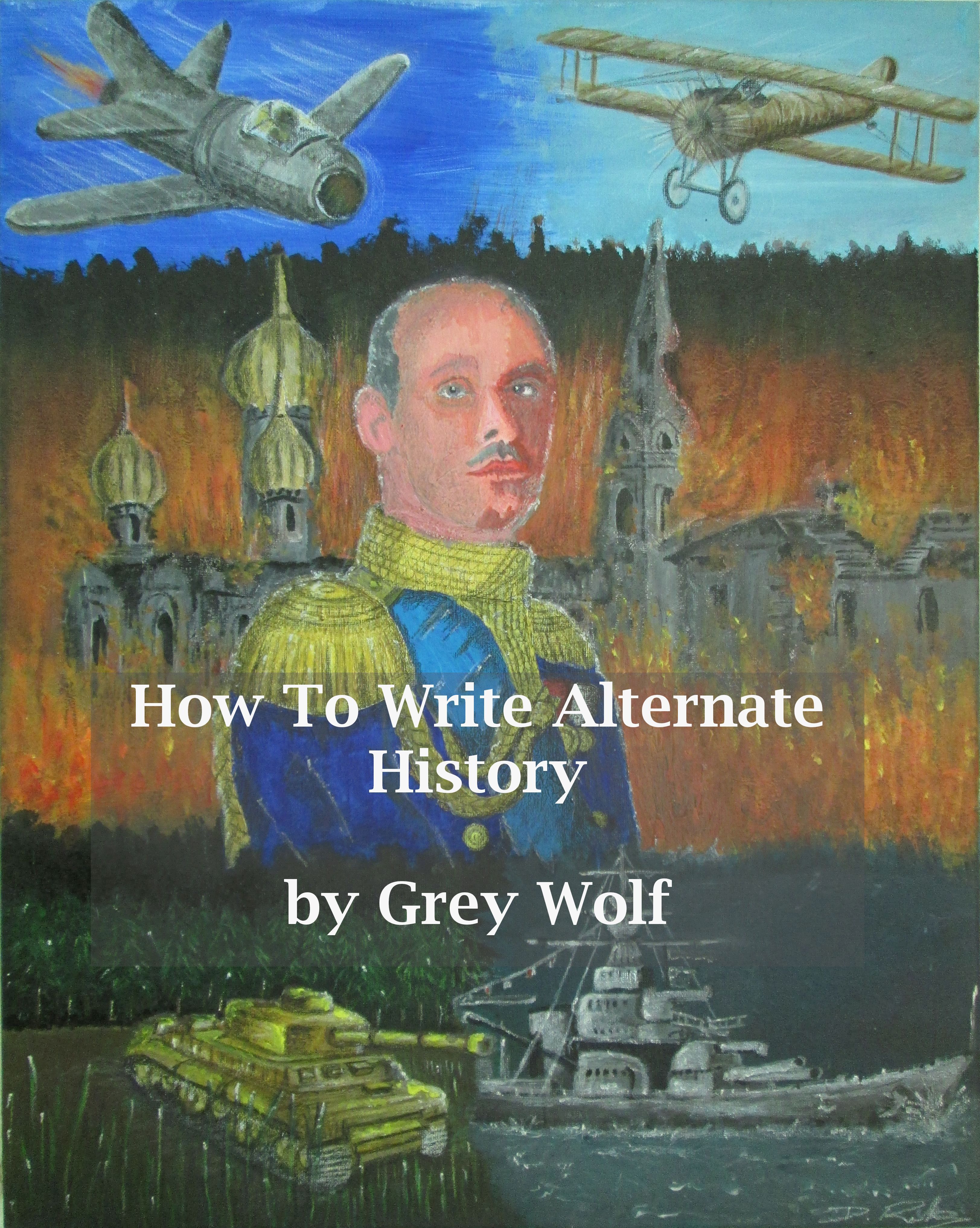
Click the cover to purchase the paperback
How To Write Alternate History is a series of articles by Grey Wolf, examining subjects such as the identity of man, whether man makes the weather, how the everyday in an alternate world is going to be changed and what names for music, vehicles, weapons etc would be different.

